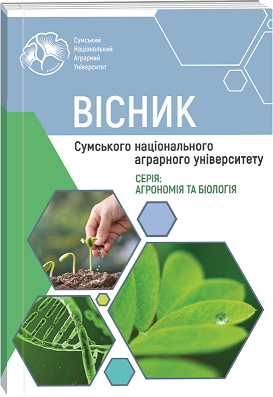INFLUENCE OF SOWING METHODS ON THE DURATION OF CERTAIN INTERPHASE PERIODS AND THE GROWING SEASON OF MAIZE
Abstract
The article investigates the influence of sowing methods on the duration of individual parts and the entire growing season by years of research in maize hybrids of different maturity groups. Field, laboratory, and statistical methods were used in the research. Two factors were taken for analysis: factor A maize hybrids of different maturity groups (SI Talisman (FAO 200), SI Photon (FAO 260), NK Thermo (FAO 330), SI Zephyr (FAO 430)) and factor B sowing method (70 cm (control); 20.3×76.2 cm; 20.3×91.4 cm; 20.3×96.5 cm). The conducted studies did not establish the effect of sowing methods of the studied maize hybrids on the duration of the growing season and its individual parts. The duration of the period "sowing-seedlings" ranged from 7–11 days, "seedlings-8 leaves" – 33–40 days, "8 leaves-panicle flowering" – 17–26 days, "panicle flowering-full grain ripeness" – 49–62 days, "seedlings-full grain ripeness" – 99–128 days. The duration of the growing season and individual periods of vegetation in the studied maize hybrids did not depend on different sowing methods, but were more influenced by the biological characteristics and maturity group of the hybrid. The duration of the period "seedlings-8 leaves of corn", regardless of sowing methods, was 36 and 33 days for the hybrid SI Talisman, 36 and 34 days for SI Photon (FAO 260), 38 and 36 days for NK Thermo (FAO 330), and 40 and 37 days for SI Zefir (FAO 430), respectively, in 2021 and 2022. In the maize hybrid SI Talisman, the period of "8 leaves – flowering of panicles" was 18 and 17 days, SI Photon (FAO 260) – 19 and 19 days, NC Thermo (FAO 330) – 23 and 21 days, SI Zephyr (FAO 430) – 26 and 23 days, respectively, in 2021 and 2022. The duration of the period "flowering of panicles – full ripeness of grain" in the medium-late hybrid SI Zephyr (FAO 430) increased by 11 days compared to the early ripe hybrid SI Talisman (FAO 200). The longest duration of the period "germination-full grain ripeness" was observed in the medium-late hybrid SI Zephyr (FAO 430) – 128 and 120 days, and the shortest in the early-ripening hybrid SI Talisman (FAO 200) – 105 and 99 days, respectively, in 2021 and 2022.
References
2. Chernobai, L. (2020). FAO kukurudzy: na shcho vplyvaie ta yak obyraty [FAO corn: what influences and how to choose]. Propozytsiia. №1. Access mode: https://propozitsiya.com/ua/fao-kukurudzy-na-shcho-vplyvaye-ta-yak-obyraty (in Ukrainian)
3. Kaletnik, H.M., Palamarchuk, V.D., Honcharuk, I.V., Yemchyk, T.V. & Telekalo, N.V. (2021). Perspektyvy vykorystannia kukurudzy dlia enerhoefektyvnoho ta ekolohobezpechnoho rozvytku silskykh terytorii: monohrafiia [Prospects for the use of corn for energy efficient and environmentally friendly development of rural areas: a monograph]. FOP Kushnir Yu. V., Vinnytsia. 260 (in Ukrainian)
4. Kokovikhin, S.V., Piliarskyi, V.H. & Piliarska, O.O. (2015). Rist i rozvytok roslyn kukurudzy na diliankakh hibrydyzatsii v umovakh zroshennia pivdnia Ukrainy [Growth and development of maize plants in hybridization plots under irrigation conditions in southern Ukraine]. Zroshuvane zemlerobstvo: zbirnyk naukovykh prats, 63, 95-97 (in Ukrainian)
5. Kovalenko, O.A., Palamarchuk, V.D. & Krychkovskyi, V.Y. (2022). Erbe der europäischen wissenschaft wirtschaft, management, erziehungswissenschaften, psychologie, landwirtschaft, kunstgeschichte heritage of european science economics, management, education, psychology, agriculture, art history. «Maize as a source of starch and bioethanol: conditions and cultivation elements. Monographic series «European Science». Karlsruhe 2022, Book 9, Part 2, 95–119.
6. Lebid, Ye. M., Tsykov, V. S. & Pashchenko, Yu. M. (2008). Metodyka provedennia polovykh doslidiv z kukurudzoiu [Methodology of field experiments with corn]. Dnipropetrovsk. 27 (in Ukrainian)
7. Liubar, V. (2015). Orhanohenez kukurudzy yak tekhnolohichna skladova [Corn organogenesis as a technological component]. Zerno, 3(108), 98-102. (in Ukrainian)
8. Mazur, V.A., Palamarchuk, V.D., Polishchuk, I.S. & Palamarchuk, O.D. (2017). Novitni ahrotekhnolohii u roslynnytstvi [The latest agricultural technologies in crop production]. FOP Rohalska I.O., Vinnytsia, 588 (in Ukrainian)
9. Palamarchuk, V. D. & Kolisnyk, O. M. (2022). Suchasna tekhnolohiia vyroshchuvannia kukurudzy dlia enerhoefektyvnoho ta ekolohobezpechnoho rozvytku silskykh terytorii: monohrafiia. [Modern technology of corn cultivation for energy-efficient and environmentally friendly development of rural areas: monograph]. Druk LLC, Vinnytsia, 372 (in Ukrainian)
10. Palamarchuk, V. D., Krychkovskyi, V.Iu., Rudska, N.O. & Kolisnyk, O. M. (2023). Novitni tekhnolohii vyroshchuvannia ovochevykh kultur ta kukurudzy za vykorystannia dyhestatu biohazovykh stantsii: monohrafiia [The latest technologies for growing vegetables and corn using digestate from biogas plants: a monograph]. Drukarnia «Druk», Vinnytsia, 296 (in Ukrainian)
11. Palamarchuk, V.D., Didur, I.M., Kolisnyk, O.M. & Aleksieiev, O.O. (2020). Aspekty suchasnoi tekhnolohii vyroshchuvannia vysokokrokhmalnoi kukurudzy v umovakh Lisostepu pravoberezhnoho: monohrafiia [Aspects of modern technology of high-starch maize cultivation in the right-bank forest-steppe: monograph]. TOV Druk, Vinnytsia, 536 (in Ukrainian)
12. Palamarchuk V.D. & Kovalenko O.A. (2019). Tryvalist okremykh mizhfaznykh ta vehetatsiinoho periodiv hibrydiv kukurudzy zalezhno vid strokiv sivby [Duration of individual interphase and vegetation periods of maize hybrids depending on sowing dates]. Tavriiskyi naukovyi visnyk. 106. 119–127 (in Ukrainian)
13. Palamarchuk, V. D., Mazur, O.V., Shevchenko, N.V. & Mazur, O.V. (2021). Elementy struktury vrozhaiu hibrydiv kukurudzy zalezhno vid vnesennia biolohichnykh preparativ v umovakh Lisostepu pravoberezhnoho [Elements of the yield structure of maize hybrids depending on the introduction of biological preparations in the right-bank forest-steppe]. Silske hospodarstvo ta lisivnytstvo. 4 (23). 244–252. (in Ukrainian)
14. Ushkarenko, V.O., Nikishenko, V.L., Holoborodko, S.P. & Kokovikhin, S.V. (2009). Dyspersiinyi i koreliatsiinyi analiz rezultativ polovykh doslidiv: monohrafiia [Analysis of variance and correlation of the results of field experiments: a monograph]. Ailant, Kherson. 372 (in Ukrainian)
15. Ushkarenko, V.O., Vozhehova, R.A., Holoborodko, S.P. & Kokovikhin, S.V. (2014). Metodyka polovoho doslidu (Zroshuvane zemlerobstvo) [Field experiment methodology (Irrigated agriculture)]. Hrin D.S., Kherson. 448 (in Ukrainian)
16. Vovkodav, V. V. (2001). Metodyka derzhavnoho sortovyprobuvannia silskohospodarskykh kultur. Vyp. 2. Zernovi, krupiani ta zernobobovi kultury [Methodology of state variety testing of agricultural crops]. Alefa, Kyiv. 64 (in Ukrainian)

 ISSN
ISSN  ISSN
ISSN 



